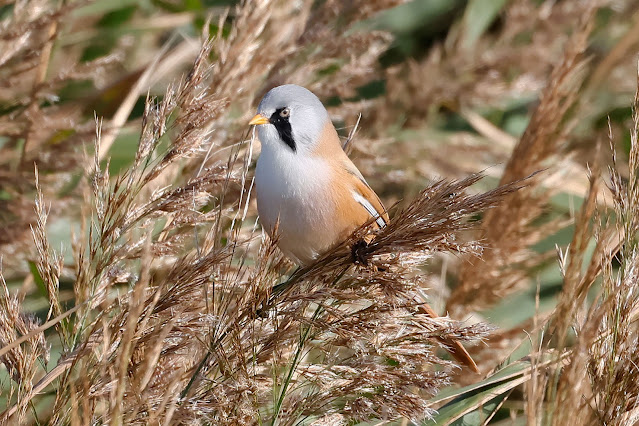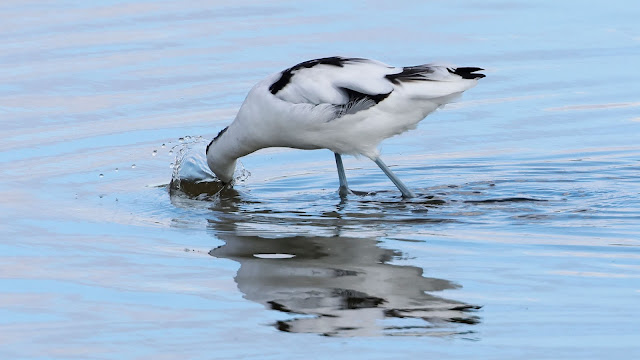Saturday I had come to terms with the fact that I was not going to see the Wryneck and that it had flown on. Then, on Sunday the report came in that it had been seen in the same place early afternoon. That afternoon and early evening there was quite a bit of rain and then it was overcast overnight. So, I thought it might now still be there, so I set off in the morning back to Titchfield. I decided to park along the sea wall, so that I was close to the car and the area where the Wryneck had been seen the most. As I was paying for the parking I could hear Bearded Tits calling from the reeds close to the road, so after putting the ticket in the car I headed to to the area and yes, there were Bearded Tits, and even better several males.
The flock was very vocal and they moved around closely together. Here a male and female or maybe juvenile.
The classic Bearded Tit pose amongst the reeds.
Again a male and probable female.
I counted ten birds in the flock and three to four males.
They moved along the edge of the reeds towards Duck Bay and continued to show very well, so I took advantage of the experience.
Finally the flock flew across the bay and into the reeds on the other side. I decided to walk on and check in at he visitor centre, but before going there I checked the roost on the beach behind the sail boats. It was only Turnstone, no Sanderling but some lovely light.
After checking in I headed towards the west side and debated whether to go and look for the Wryneck. I decided to walk along the footpath, probably more in hope. A Jay flew across the area, a sign that the seasons were changing and the Jays were starting to cache food for the winter.
Nothing else was showing in the bushes, but a bird on the roof of the nearby chalet looked interesting, but turned out to be a Wheatear, although I did try to make it something else, more of which later.
I was able to get closer to the Wheatear and it looked a lot stockier and short-tailed.
The tail also had a white tip to it which I had not seen on a Wheatear before.
But after soliciting some expert opinions it was agreed it was just a Wheatear.
I went on to the reserve and started in the Meon Shore Hide. There were two Glossy Ibis were feeding on the far side of the north scrape. A Marsh Harrier appeared and put the birds on the scrape up and this flushed the Glossy Ibis. Both flew to the south scrape north west corner, in front of the Pumfrett Hide.
I walked and jogged around to the hide and when I arrived they were on the right hand side of the hide, the light was bad but I managed to open the window without disturbing them, then one of the occupants decided to open another window near me and wasn't so careful and flushed the Ibis.
I decided to walk on to the Spurgin Hide and settling in the Kingfisher flew in, but didn't stay long. A Great Egret was at the back of the scrape and was keeping away from a Grey Heron that was close by.
It came down one of th channels towards the hide.
It then decided to fish at the back of the pond, dashing about and dancing across the water. The Grey Heron not too bothered.
Over the last few weeks I have been able to watch the hunting and walking behaviour of the three Egrets we no get here in the south. The Little Egret appears to be the least dramatic, using its feet to stir the mud being the only distinction. The Cattle Egret walks around pushing the head forward as it walks like a child's toy. The Great Egret walks with the beak pointing at 45 degrees, this probably allows the eys to see down into the water.
It was approaching lunch time and this was the time the Wryneck would show if present, so I left the Spurgin and headed to the sea wall, but stopped to have some time in the Meopon Shore Hide. There were eight Avocet feeding in front of the hide, the water reflecting nicely the blue sky above.
This was a juvenile bird, there is quite a bit of grey plumage on the neck.
On the island to the left of the hide were five Snipe, four on the island and one in the water close by.
A Black-tailed Godwit reflecting in the blue water.
The Snipe were feeding close by, the Snipe reflecting in the water that was still a pale blue in colour.
I made my way to the west end of the footpath and settled in with my lunch to wait for the Wryneck to show. I was there for just under two hours and of course there was nothing. The only birds of note were the number of Mediterranean Gulls overhead moving from the beach, the reserve and from over Brownwich.
I headed back to the Spurgin Hide and managed to get the pole position of the left hand side of the hide. Almost immediately a Kingfisher appeared, am le and it sat on the closet post o me in the hide.
I thought this was going to result in it throwing up a pellet, but it didn't.
It then settled down before flying off.
But not too far settling on another post just a little further away.
It flew off but was back again and made a brief visit to the post closest to me, I just wish it had turned its head before flying off.
It flew to another post and from here it made several dives.
Eventually it came up with a catch but wasn't a fish, but what looks like either a dragonfly or Great Diving Beetle nymph.
After swallowing the nymph, it flew to some old posts low down to the water.
And then started to dive into the water to bathe.
Returning to the post where it would then repeat the activity at least four times.
Then it went to another post where there was some extensive preening.
Then it was off and so was I. No Wryneck, I have now come to terms with this, but some great views of some quality birds.


























































No comments:
Post a Comment